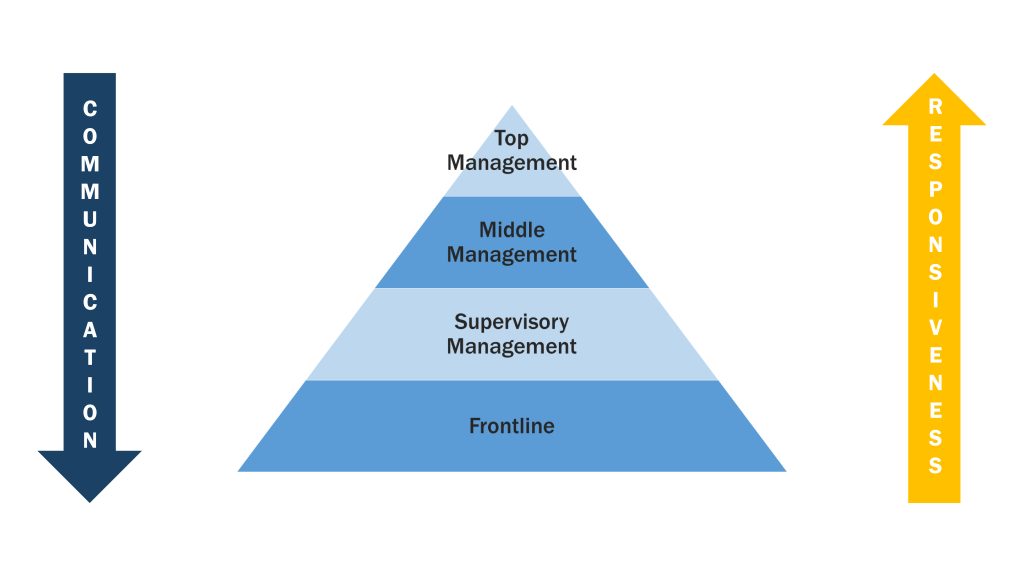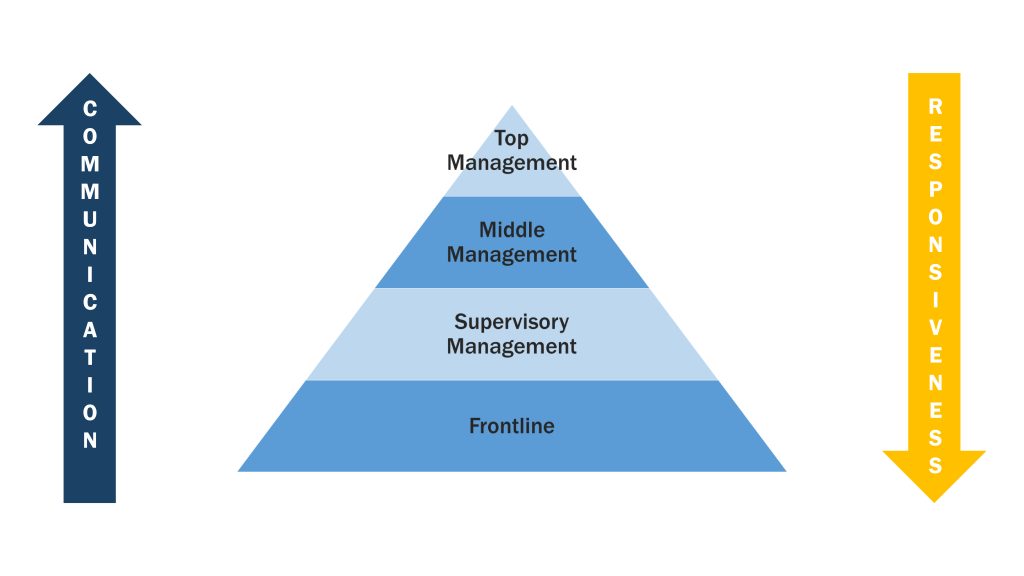There is a practical appeal of our flagship product, the Situational Leadership® Model. However, after more than 50 years, two common questions arise. Is Situational Leadership® still relevant? If so, how?
How Has Leadership Changed Since The 1970s?
There can be no denying that effectively influencing people today is a far cry from what it was in the 1970s. By today’s standards, the pace of change is unrecognizable compared to when the model was introduced. Back then, information was in the hands of the few. Organizations were structured to reflect that reality. The communication flowed almost exclusively from the top of the organization to its base. Responsiveness migrated almost exclusively in the opposite direction. Metaphorically, leaders were the people who descended from their elevated perch when things needed to be done, and the rest were conditioned to hear what they had to say, then act.
What’s different about leadership five decades later?
- Ongoing, never-ending, disruptive change
- Daunting tasks
- Exponentially increasing complexity
- Rampant uncertainty
Because we have been so conditioned for so long to look for answers from the upper levels of the organization when we hit a stumbling block, we continue to look to those leaders.
Leaders then arrive with shared challenges instead. Challenges so complex they are forcing us to fundamentally rethink what leadership is, where it comes from and how it works. In many situations leaders currently face, it’s like the flow of both communication and responsiveness have been effectively reversed.
How Has Leadership Training Changed?
Leadership training in the 1970s was very different as well. First off, it was almost exclusively reserved for those who had been promoted into a formal people-management role. in the context of Situational Leadership®, those participants learned how to:
- Identify the tasks that needed to be performed.
- Assess the readiness of the individual or team performing them.
- Employ a leadership approach that matched the assessment.
- Manage the movement.
The Role of Situational Leadership® Today
Situational Leadership® has never been more relevant. As evidenced by research from The Josh Bersin Company, the employee experience is a complicated integration of strategic, tactical and interpersonal dynamics. In combination, they represent components of the irresistible organization described below. Situational Leaders impact these dynamics each and every day.
The Irresistible Organization
Meaningful Work
The organization has a noble purpose. It is important the dreams, aspirations and values of the people that work there are connected to and aligned with that organizational purpose. Work matters because the mission of the organization matters, and the people who have committed to fulfilling that mission matter even more.
Strong Management
Performance goals and expectations are clear. People know what they are supposed to do and how that activity connects to the achievement of a noble purpose. They also know how those contributions will be measured and calibrated accordingly. They know because they probably played an active role in establishing those goals and mechanisms for measurement themselves.
Positive Workplace
People feel safe. They can speak candidly and openly about the work they do, how they do it and how it might be done better in the future. There are consequences, accountability and timely feedback, for anyone at any level in the organization that impedes that vibe in any way.
Health and Well-Being
The organization intentionally encourages employees to pursue personal fitness, health and physical well-being. Beyond that, the organization removes barriers so that employees can make personal fitness a priority for themselves. The same goes for psychological and emotional well-being and support.
Growth Opportunity
Career development is actively supported, facilitated and personalized. These discussions are open, ongoing and iterative. Above all else, the organization emphasizes the importance of learning and the role learning how to learn plays in both employee satisfaction and organizational success, regardless of the chosen career path.
Trust in the Organization
The organization, as represented by its executive stewards, has a track record of both transparency and credibility. There is sincere alignment between the stated mission, the articulated strategy in place to achieve that mission and the tactical priorities that drive day-to-day operations.
For leadership training to be useful, it has to be relevant.
Situational Leadership® & The Irresistible Organization
Of the six characteristics of the ideal organization, Situational Leadership® aligns with and contributes directly to three of them.
Meaningful Work
The employee buys into the noble purpose of the organization and feels the work they do matters. There is a sense of fulfillment that is derived from the active pursuit of that purpose that is difficult to accurately quantify.
The Role of Agility
When it comes time to execute in service of the noble purpose, meaningful work translates to a work culture defined by agility. The essence of agility in action is:
- Alignment
- Baby steps
- Measurement/Calibration
- Alignment
- More baby steps
- Rinse and repeat
We would offer that Situational Leadership® is a language of agility. It is a practical, repeatable, road map that leaders and followers can reference and leverage as a communication tool to determine and prioritize a plan of action. Here are the steps Situational Leaders employ in that regard
- Step 1: Align with followers on the task or activity that needs to be performed. If complex, the task needs to be considered at its lowest common denominator and prioritized accordingly
- Step 2: Align with followers on their readiness to perform the prioritized task(s). Readiness is an objective assessment of the follower’s current ability and willingness to perform and is the product of an inclusive and transparent exchange between the leader and the follower
- Step 3: Provide a leadership style that aligns with the outcome of Steps 1 and 2. Leaders need to be able to respond to the performance needs of those they influence by empowering, participating or directing the baby steps that are about to be taken
- Step 4: Manage the movement that is evidenced through measurement and calibration. The objective is to act as a catalyst for performance-related growth and development, and to redirect performance slippage or regression
Strong Management
Those with talent, aspirations and unrealized potential seek managers that have demonstrated the ability to transform potential into reality. In the ongoing war for talent, a culture defined by effective leadership and coaching has a distinct competitive advantage.
Clear Goals With Stretch Opportunities
The first thing Situational Leaders align with followers around is the task that needs to be accomplished. What needs to be done, by when and why? A key determining factor a strong performance coach will take into objective consideration is the transferable skill and related experience the person they are influencing has demonstrated for the task in question. The more that individual has relevant grounding and has mastered the fundamentals of performance, the more opportunity they get to stretch, grow, reach and realize.
Regular Coaching and Feedback
Situational Leadership® is a language of performance management. The model provides coaches in any setting with a template of consideration for both planned and unplanned feedback and coaching opportunities:
- What is the task?
- What is the Performance Readiness® of the person relative to the task/subject under consideration?
- What is the style with the highest probability of success?
A Focus on Management Development
Organizations that have a reputation for strong management align with the foundational competencies of Situational Leadership® as they identify, cultivate and sustain management excellence.
They typically have rigorous and highly competitive Management Development programs. These programs ensure candidates are fully aware of, and prepared for, a career transition into people management and have demonstrated the potential to be successful. Newly promoted managers receive a focused orientation as well as targeted, ongoing training. This training is sequenced at a pace that prioritizes internalization and emphasizes mastery of diagnosis, adaptation and communication.
Trust In The Organization
There is no one best way to lead. Each leadership style can be effective or, conversely, ineffective. Effectiveness is usually a function of two things:
- The situation: The task that needs to be accomplished, in combination with the Performance Readiness® Level of the person performing it.
- Power: The influence potential of the leader.
In this regard, leadership and power are literally flip sides of the same influence coin. Power is the energy that drives effective leadership. No power? No influence! And that energy originates from two highly interdependent sources in organizations:
- Your position: Position power refers to the comparative degree of responsibility and authority one has for making decisions. Those occupying formal leadership positions in organizations are judged (routinely) by the quality of those decisions. Leaders that make quality decisions perceived to be in the best interests of a wide spectrum of stakeholders earn the trust and commitment of those they influence. Leaders that make poor decisions, or abuse their authority, do not.
- Your reputation: Personal power is the comparative degree of trust and commitment you have earned with those you attempt to influence. Trust is a subjective function of factors such as:
- Sincerity: Do others believe what you say?
- Reliability: Do you consistently follow through on what you say you are going to do?
- Competence: Do you have “the juice” to do what you say you are going to do?
Transparency, Empathy and Integrity of Leadership
The easiest way for a Situational Leader to assess the Performance Readiness® of a follower for a particular task is to ask:
- How much experience do you have with this kind of thing?
- How would rate your skill level for this?
- On a scale of 1-10, how confident are you that we’re going to meet this deadline?
- How much do you enjoy this aspect of your contribution?
- Etc.?
Open, authentic discussion is the most effective means for a leader and a follower to align on Performance Readiness® for a task, as well as the approach the leader needs to employ as a result. When others trust you as a leader, they tell you the truth! In the absence of trust, there is misinformation. This not only puts performance goals at risk, but it also challenges the ongoing validity of the relationship.
Continuous Investment in People
What do you do if you are a leader formally in charge of a team responsible for delivering several outcomes and your people don’t trust you? Do you wait until you build trust before you lead? Or do you lead as a means of establishing and fostering trust?
Situational Leaders match their style or approach to the performance needs of their followers. They recognize the most inconsistent thing they can do as a leader is to treat everyone the same. The process of aligning approach with performance need is a practical, repeatable strategy leaders can leverage to deliver results and cultivate trust regardless of the task or the impact of disruptive change.
Effective leadership builds trust and trust positions leaders to be effective!
Contact The Center For Leadership Studies
Contact the Center For Leadership Studies today to grow your team!



